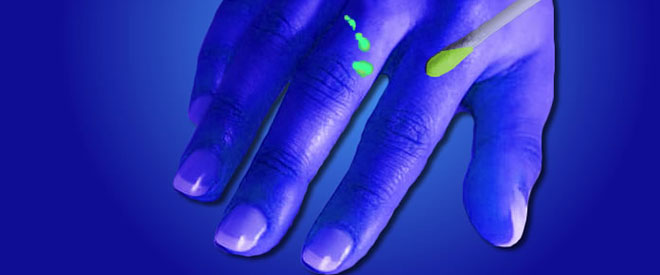Fluorescent Dye Could Improve Evidence Collection For Rape Victims With Darker Skin Tones

Forensic nurses fully document sexual assault victims' injuries by using a dye that causes injuries to the skin to "light up."
A key piece of forensic evidence in a rape case often goes uncollected for people with darker complexions -- simply because the tool used to collect it does not work well on darker skin pigments. Now, scientists at the University of Virginia are trying to change that with a new approach.
Hidden in plain sight
After a rape, one of the first and most critical procedures a forensic nurse will follow is to document the victim’s injuries thoroughly. The problem is that many of the injuries caused by a rape are small tears and lacerations that are difficult to see with the naked eye.
So, the forensic nurse will typically apply a blue staining dye called toluidine blue to the victim’s skin. Once the excess dye is wiped away, any previously unseen lacerations, tears or abrasions on the skin will ‘light up’ in contrast to the rest of the skin and can be detected. According to Kathryn Laughon, an associate professor of nursing at U.Va., nurses are able to see and record two to three times more injuries with the dye than without.
Unfortunately, toluidine blue works poorly on darker skin pigments. The dye relies on contrast with the surrounding skin to expose the tiny injuries. For people with lighter skin, the dye creates a stark contrast between the injured and uninjured tissue. But for people with darker skin tones, the dye provides less contrast and the injuries are not as well documented. Without the proper documentation of the victim’s injuries, it is much more difficult to prosecute and convict the perpetrator.
A vulnerable demographic
A 2013 report by the U.S. Department of Justice found that while overall violent crime decreased by 58 percent between 1995 and 2010, women, particularly African American women, are still at risk of sexual assault and rape. The report estimates that between 2005 and 2010, 2.2 of every 1,000 Caucasian women 12 or older were raped, and 2.8 of every 1,000 African American women were raped. African American women are also less likely to report a rape or attempted rape and less likely to have their case moved through the justice system if they do report it. Researchers at U.Va. suggest that the lag in convictions of African American women’s rape cases may be due in part to the ineffective dye and the resulting lack of forensic evidence.
Shedding new light
In response, researchers at U.Va.’s School of Nursing are experimenting with fluorescent dyes to replace toluidine blue. Fluorescent dyes are made up of chemical compounds called fluorophores. A fluorophore molecule is able to absorb light energy of a specific wavelength and reflect it at a longer wavelength.
So, a fluorescent dye would be able to illuminate the victim’s wounds regardless of his or her skin color.
Now, researchers are experimenting with existing fluorescent dyes to figure out which kind of dye is able to capture injuries on all skin hues without causing irritation or pain and without compromising any necessary DNA tests performed afterward.
From there, researchers plan to test the dye’s effectiveness by using it on women immediately following consensual sex – even consensual sex causes small tears and lacerations that could be illuminated by the dye. This testing will also give researchers an idea of the difference between injuries sustained from a consensual sexual encounter and injuries from a non-consensual encounter.
Future funding
The U.Va. research team is using a fundraising method called crowdfunding. The project, Reducing Inequity in Forensic Exams Following Sexual Assault, aims to raise $19,000 to develop the fluorescent dye.
